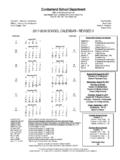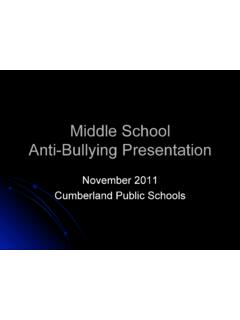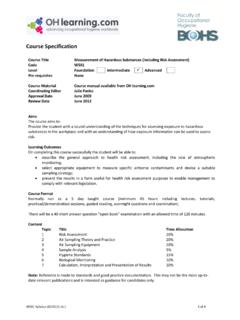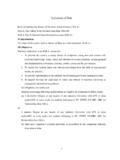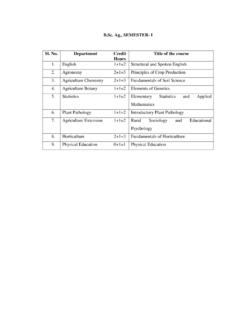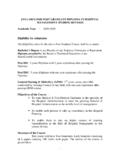Transcription of Cumberland High School General Chemistry Syllabus
1 Cumberland high School General Chemistry Syllabus Teacher Miele, Robinson, White Phone 658-2600 Room E-mail Hours Daily Text: Chemistry , a Natural Approach Lab-Aids, 2010 course Description: Students explore the fundamental principles of Chemistry which characterize the properties of matter and how it reacts. Computer-based and traditional laboratory techniques are used to obtain, organize and analyze data. Conclusions are developed using both qualitative and quantitative procedures. Topics include, but are not limited to: measurement, atomic structure, electron configuration, the periodic table bonding, gas laws, properties of liquids and solids, solutions, stoichiometry, reactions, kinetics, equilibrium, acids and bases, and nuclear Chemistry Main Goals: The main goal of this program is to provide a solid foundation in the study of matter and its changes.
2 Through many activities students will demonstrate how theory is applicable in laboratory situations. All students will develop good methods of problem solving and proper laboratory techinique Grade Span Expectations: PS1 All living and nonliving things are composed of matter having characteristic properties that distinguish one substance from another. PS2 Energy is necessary for change to occur in matter. Energy can be stored, transferred and transformed butn can not be destroyed. M(N&O)10-4 Accurately solves problems that involve but are not limited to proportional relationships, percents, ratios and rates M(N&O)12-4 Accurately solves problems involving scientific totation or uses significant digits to assess the precision of an answer M(G&M)10-7 Uses units of measure appropriately and consistently when solving problems across content strands; Makes conversions within or across systems and makes decisions concerning an appropriate degree of accuracy in problem situations involving measurement.
3 M(F&A)10-1 Identifies, extends and generalizes a variety of patterns (linear and nonlinear) represented by models, tables, sequencesor graphs to solve problems. M(F&A)10-3 Demonstrates conceptual understanding of algebraic expressions by solving problems M(F&A)10-1 Interprets a given representation to make observations, to answer questions , to analyze the data to formulate or justify conclusions. M(DSP)10-2 analyzes patterns, trends or distributions in data in a variety of contexts. Requirements: Laboratory Activities: Chapter tests/quizzes Research Projects Resources: Hand held Probeware (Vernier) Computers on Wheels General Laboratory Equipment Evaluation: Quarterly grades will be determined on a total point basis. The following guidelines are an approximation of the possible point values for various assignments.
4 Tests 100 points Quizzes 10-50 points Homework 5 points Projects 50-200 points Quarter/week Topic Assignment Extensions 1/1 Lab Safety & Equipment Lab Equipment Safety Scavenger Hunt Safety Symbols 1/3 Introduction to Chemistry Branches of Chemistry 1/4 The SI System of Measurement Measuring Mass, Length & Volume Accuracy & Precision Numbers in Science Adventures in Density Density Curve Error Analysis Significant Figures 1/7 Matter.
5 Change & Energy Classification of Matter Separating Mixtures Energy Calorimetry 1/10 Common Task Think Before You Ink 2/11 History of the Atomic Model Time Line Rutherford s Experiment Quantum Numbers 2/13 Electrons in Atoms Electron Configurations Orbital Notation Lewis Dot Diagrams 2/15 The Electromagnetic Spectrum Flame Test Wave Equations 2/17 The Periodic Table Alien Periodic Table It s in the Cards (trends) 2/19 Common Task Comet 3/20 Ionic and Metallic Bonding Characteristics of Ionic Compounds 3/21 Names & Formulas of Ionic Compounds Naming & Writing Formulas 3/23 Covalent Bonding Molecular Geometry Drawing Lewis Structures 3/24 Names & Formulas Covalent Distinguishing Ionic from Resonance Compounds Covalent Compounds 3/25 Chemical Quantaties The Mole Concept 3/26 Mole-Mass Conversions Moles of Silver & Copper 3/27 Mole-Volume Relationships Moles of Gases 3/28 Chemical Reactions Balancing Equations Classifying Chemical Reactions
6 Stoichiometry Limiting Reactants 4/29 The Behavior of Gases Boyle s Law Ideal Gas Law 4/31 Acids, Bases & Salts the pH scale Choosing Indicators 4/32 Final Exams Major Assessments: Common Tasks Comet (on demand) Think Before you Ink (on demand) Common course Assessment Core Laboratory Activities Formal Laboratory Reports Projects Know Your Element Atomic Model Time Line CHS MISSION STATEMENT Through a partnership with parents and community, CHS will produce life-long learners who demonstrate logical thinking, effective communication and responsible citizenship. Our learning environment is predicated on academic rigor, consideration for a wide variety of teaching/learning styles and diverse artistic, social and athletic opportunities for everyone in a safe atmosphere of tolerance, courtesy and mutual respect.
7 STUDENT EXPECTATIONS CHS students 1. demonstrate an active involvement in their learning. 2. demonstrate logical thinking and problem solving ability. 3. effectively communicate through writing, listening, speaking, and reading across all content areas. 4. demonstrate the ability to locate, organize, evaluate, and utilize different sources of information and/or data. 5. identify connections between historic events and today s global society. 6. demonstrate proficiency in the Fine/Performing Arts. 7. demonstrate the concept of personal wellness to develop a safe and healthy lifestyle. 8. be responsible citizens in the community. 9. identify goals and set priorities to prepare for life and career decision making
